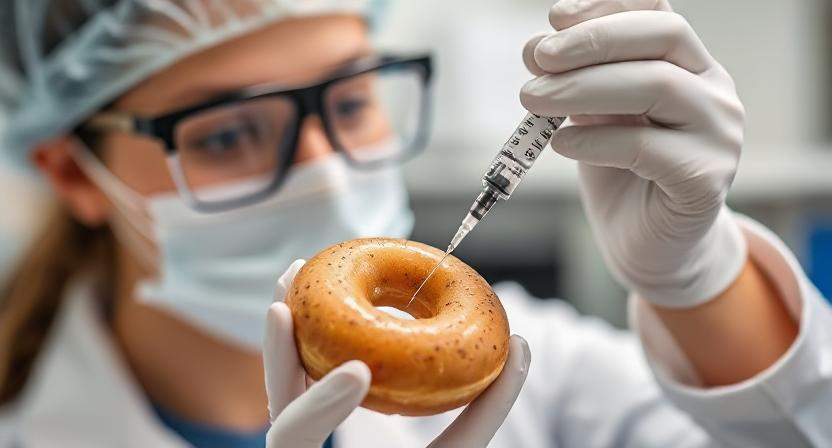

Modern Addictions: The Many Forms of Drugs in Society


Arya Soleil
When people think of drugs, they often picture illicit substances like heroin, cocaine, or prescription painkillers. However, addiction comes in many forms—some legal, some socially accepted, and some disguised as everyday pleasures. Whether in the form of refined sugar, processed fast food, caffeine, or narcotics, the modern world is full of addictive substances designed to stimulate cravings, manipulate brain chemistry, and foster dependence.
This analysis explores the hidden addictions in our society, how they affect our health, and what we can do to break free from their grasp.
The Science of Addiction: How It Works
Addiction is a biochemical process where certain substances or behaviors trigger the release of dopamine, the brain’s “reward chemical.” Whether it’s from consuming drugs, sugary foods, fast food, or caffeine, the effect is the same—an artificial and often temporary pleasure spike. Over time, the brain becomes desensitized, requiring larger amounts to achieve the same effect. This leads to dependence, withdrawal symptoms, and compulsive consumption.
Illicit Drugs: The Most Recognized Addiction
Substances like heroin, cocaine, methamphetamine, and prescription opioids are widely known for their addictive properties and destructive consequences. These drugs hijack the brain’s reward system, creating powerful cravings and severe withdrawal symptoms when discontinued. The opioid crisis, fueled by pharmaceutical companies and over-prescription, has led to a public health emergency, with millions struggling with addiction worldwide.
While illegal drugs are the most widely recognized form of addiction, other substances—those that are legal and easily accessible—can be just as dangerous in their long-term effects.
Refined Sugar: The Sweetest Addiction
Sugar is one of the most pervasive and widely consumed addictive substances in the modern world. Found in nearly every processed food, sugar activates the brain’s reward system similarly to cocaine, creating dependency and overconsumption.
Excessive sugar consumption has been linked to:
- Obesity
- Type 2 diabetes
- Heart disease
- Chronic inflammation
- Cognitive decline
Food manufacturers design products with added sugars to keep consumers coming back for more, creating an endless cycle of cravings, energy crashes, and weight gain. The addiction to sugar is often overlooked because it is legal and socially acceptable, yet it plays a major role in modern health epidemics.
Fast Food: Engineered for Dependence
Fast food is a perfect example of a chemically engineered addiction. High in unhealthy fats, refined carbohydrates, excessive sodium, and additives, these foods are designed to be hyper-palatable, meaning they trigger dopamine release in a way that encourages overconsumption.
The effects of fast food addiction include:
- Increased risk of obesity
- Poor gut health due to artificial preservatives
- Cardiovascular disease from trans fats and excess sodium
- Brain fog and sluggishness due to processed ingredients
Fast food chains use aggressive marketing, convenience, and low prices to keep customers hooked. Just like a drug, the temporary pleasure of eating junk food is followed by a crash, which fuels the desire to consume more.
Caffeine: Society’s Most Accepted Stimulant
Caffeine is one of the most widely consumed psychoactive substances in the world. Found in coffee, energy drinks, soda, and tea, caffeine works by stimulating the nervous system, increasing alertness, and temporarily warding off fatigue.
While moderate caffeine intake has some benefits, such as improved focus and metabolism, dependence on caffeine can lead to:
- Insomnia and disrupted sleep cycles
- Anxiety and jitteriness
- Increased blood pressure
- Withdrawal symptoms like headaches and fatigue
Many people rely on caffeine to function, making it an accepted yet addictive substance that fuels daily dependence.
How to Break Free from Modern Addictions
Understanding the many forms of addiction is the first step toward regaining control over your health. Here are some ways to reduce dependence on these substances:
- Reduce Processed Sugar Intake – Opt for natural sweeteners like honey, dates, or fresh fruit instead of refined sugars.
- Choose Whole, Nutrient-Dense Foods – Prioritize home-cooked meals with unprocessed ingredients to avoid the addictive additives found in fast food.
- Limit Caffeine Consumption – Reduce reliance on coffee or energy drinks by staying hydrated, prioritizing sleep, and consuming herbal teas.
- Be Mindful of Emotional Eating – Understand that food should nourish your body, not serve as a source of comfort or stress relief.
- Educate Yourself on Ingredients – Read food labels and research how different ingredients affect your body and brain.
- Seek Healthier Dopamine Sources – Replace artificial pleasure spikes with natural dopamine boosters like exercise, meditation, and fulfilling social interactions.
Final Thoughts
Addiction does not always come in the form of illegal drugs. Many of the most widely consumed substances—sugar, fast food, caffeine—are just as addictive and detrimental to long-term health. These substances manipulate brain chemistry to encourage overconsumption and dependence, leading to a cycle of cravings and health issues.
By making conscious dietary and lifestyle choices, individuals can break free from these modern addictions, reclaim their health, and cultivate a life centered around real nourishment and well-being. Awareness is the first step—once we recognize the many forms of addiction in our society, we can take active steps toward healthier alternatives and greater self-control.
Recommended Reads

- March 22, 2025
Anti-Inflammatory Breakfasts: Easy Recipes to Start Your Day Right
Home News Healthy Habits & Lifestyle Health Conditions &...


- March 22, 2025
Questioning the FDA: A Deeper Look at the Food and Drug Administration’s Role
Home News Healthy Habits & Lifestyle Health Conditions &...


- March 22, 2025
Make ‘Raw Milk’ Just ‘Milk’ Again: A Closer Look at the Raw Milk Debate
Home News Healthy Habits & Lifestyle Health Conditions &...


- March 22, 2025
The Power of Sweet Potatoes: A Superfood for Eyes, Skin, and Beyond
Home News Healthy Habits & Lifestyle Health Conditions &...


- March 22, 2025
Sugar-Free: A Code Word for “We’ve Replaced It with Something Worse for You”
Home News Healthy Habits & Lifestyle Health Conditions &...


- March 22, 2025
The Evolution of Food: How Modern Diets Are Fueling Chronic Disease
Home News Healthy Habits & Lifestyle Health Conditions &...

Modern Addictions: The Many Forms of Drugs in Society

When people think of drugs, they often picture illicit substances like heroin, cocaine, or prescription painkillers. However, addiction comes in many forms—some legal, some socially accepted, and some disguised as everyday pleasures. Whether in the form of refined sugar, processed fast food, caffeine, or narcotics, the modern world is full of addictive substances designed to stimulate cravings, manipulate brain chemistry, and foster dependence.
This analysis explores the hidden addictions in our society, how they affect our health, and what we can do to break free from their grasp.
The Science of Addiction: How It Works
Addiction is a biochemical process where certain substances or behaviors trigger the release of dopamine, the brain’s “reward chemical.” Whether it’s from consuming drugs, sugary foods, fast food, or caffeine, the effect is the same—an artificial and often temporary pleasure spike. Over time, the brain becomes desensitized, requiring larger amounts to achieve the same effect. This leads to dependence, withdrawal symptoms, and compulsive consumption.
Illicit Drugs: The Most Recognized Addiction
Substances like heroin, cocaine, methamphetamine, and prescription opioids are widely known for their addictive properties and destructive consequences. These drugs hijack the brain’s reward system, creating powerful cravings and severe withdrawal symptoms when discontinued. The opioid crisis, fueled by pharmaceutical companies and over-prescription, has led to a public health emergency, with millions struggling with addiction worldwide.
While illegal drugs are the most widely recognized form of addiction, other substances—those that are legal and easily accessible—can be just as dangerous in their long-term effects.
Refined Sugar: The Sweetest Addiction
Sugar is one of the most pervasive and widely consumed addictive substances in the modern world. Found in nearly every processed food, sugar activates the brain’s reward system similarly to cocaine, creating dependency and overconsumption.
Excessive sugar consumption has been linked to:
- Obesity
- Type 2 diabetes
- Heart disease
- Chronic inflammation
- Cognitive decline
Food manufacturers design products with added sugars to keep consumers coming back for more, creating an endless cycle of cravings, energy crashes, and weight gain. The addiction to sugar is often overlooked because it is legal and socially acceptable, yet it plays a major role in modern health epidemics.
Fast Food: Engineered for Dependence
Fast food is a perfect example of a chemically engineered addiction. High in unhealthy fats, refined carbohydrates, excessive sodium, and additives, these foods are designed to be hyper-palatable, meaning they trigger dopamine release in a way that encourages overconsumption.
The effects of fast food addiction include:
- Increased risk of obesity
- Poor gut health due to artificial preservatives
- Cardiovascular disease from trans fats and excess sodium
- Brain fog and sluggishness due to processed ingredients
Fast food chains use aggressive marketing, convenience, and low prices to keep customers hooked. Just like a drug, the temporary pleasure of eating junk food is followed by a crash, which fuels the desire to consume more.
Caffeine: Society’s Most Accepted Stimulant
Caffeine is one of the most widely consumed psychoactive substances in the world. Found in coffee, energy drinks, soda, and tea, caffeine works by stimulating the nervous system, increasing alertness, and temporarily warding off fatigue.
While moderate caffeine intake has some benefits, such as improved focus and metabolism, dependence on caffeine can lead to:
- Insomnia and disrupted sleep cycles
- Anxiety and jitteriness
- Increased blood pressure
- Withdrawal symptoms like headaches and fatigue
Many people rely on caffeine to function, making it an accepted yet addictive substance that fuels daily dependence.
How to Break Free from Modern Addictions
Understanding the many forms of addiction is the first step toward regaining control over your health. Here are some ways to reduce dependence on these substances:
- Reduce Processed Sugar Intake – Opt for natural sweeteners like honey, dates, or fresh fruit instead of refined sugars.
- Choose Whole, Nutrient-Dense Foods – Prioritize home-cooked meals with unprocessed ingredients to avoid the addictive additives found in fast food.
- Limit Caffeine Consumption – Reduce reliance on coffee or energy drinks by staying hydrated, prioritizing sleep, and consuming herbal teas.
- Be Mindful of Emotional Eating – Understand that food should nourish your body, not serve as a source of comfort or stress relief.
- Educate Yourself on Ingredients – Read food labels and research how different ingredients affect your body and brain.
- Seek Healthier Dopamine Sources – Replace artificial pleasure spikes with natural dopamine boosters like exercise, meditation, and fulfilling social interactions.
Final Thoughts
Addiction does not always come in the form of illegal drugs. Many of the most widely consumed substances—sugar, fast food, caffeine—are just as addictive and detrimental to long-term health. These substances manipulate brain chemistry to encourage overconsumption and dependence, leading to a cycle of cravings and health issues.
By making conscious dietary and lifestyle choices, individuals can break free from these modern addictions, reclaim their health, and cultivate a life centered around real nourishment and well-being. Awareness is the first step—once we recognize the many forms of addiction in our society, we can take active steps toward healthier alternatives and greater self-control.
Recommended Reads

- March 22, 2025
Anti-Inflammatory Breakfasts: Easy Recipes to Start Your Day Right
Home News Healthy Habits & Lifestyle Health Conditions &...


- March 22, 2025
Questioning the FDA: A Deeper Look at the Food and Drug Administration’s Role
Home News Healthy Habits & Lifestyle Health Conditions &...


- March 22, 2025
Make ‘Raw Milk’ Just ‘Milk’ Again: A Closer Look at the Raw Milk Debate
Home News Healthy Habits & Lifestyle Health Conditions &...


- March 22, 2025
The Power of Sweet Potatoes: A Superfood for Eyes, Skin, and Beyond
Home News Healthy Habits & Lifestyle Health Conditions &...


- March 22, 2025
Sugar-Free: A Code Word for “We’ve Replaced It with Something Worse for You”
Home News Healthy Habits & Lifestyle Health Conditions &...


- March 22, 2025
The Evolution of Food: How Modern Diets Are Fueling Chronic Disease
Home News Healthy Habits & Lifestyle Health Conditions &...



